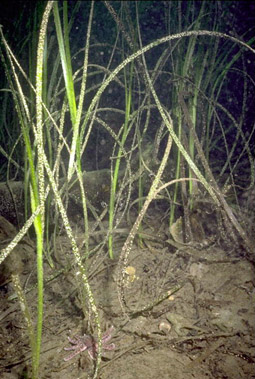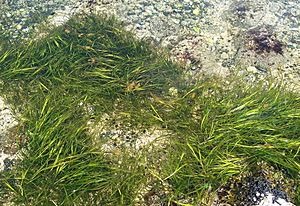Marine eelgrasses facts for kids
Quick facts for kids Zostera (marine eelgrasses) |
|
|---|---|
 |
|
| Zostera marina | |
| Scientific classification |
|
| Kingdom: | Plantae |
| Clade: | Tracheophytes |
| Clade: | Angiosperms |
| Clade: | Monocots |
| Order: | Alismatales |
| Family: | Zosteraceae |
| Genus: | Zostera L. |
 |
|
| Global distribution map of Zostera. Green indicates presence. | |
| Synonyms | |
|
|

Zostera is a type of seagrass that grows in the ocean. It's often called marine eelgrass or just eelgrass. Some fishermen and boaters might even call it seaweed. There are about 15 different kinds, or species, of Zostera found around the world. These amazing plants are super important for ocean life!
Contents
What is Eelgrass?
Eelgrass plants, like Zostera marina, usually grow in sandy areas or in estuaries (where rivers meet the sea). They are often completely underwater or floating on the surface. Most types of Zostera are perennial, meaning they live for more than two years.
These plants have long, bright green leaves that look like ribbons, usually about 1 centimeter (0.4 inches) wide. Short stems grow up from white, branching rhizomes. Rhizomes are like underground stems that help the plant spread. The flowers of eelgrass are hidden inside the bottom parts of the leaves. Their fruits are like small, puffy bladders that can float.
Why Eelgrass is Important
Beds of Zostera are super important for the ocean environment. They help to:
- Catch sediment: They slow down water, allowing sand and mud to settle.
- Keep the ground stable: Their roots and rhizomes hold the seabed together, stopping erosion.
- Provide homes: They offer a place for tiny algae and small sea creatures to live.
- Act as nurseries: Many young fish and shellfish, which are important for fishing, grow up safely in eelgrass beds.
- Provide food: Zostera is a key food source for birds like brant geese and wigeons.
Sometimes, a tiny organism called Labyrinthula zosterae (a type of slime mold) can cause a disease in Zostera. This disease can make eelgrass populations shrink, which then affects the animals that rely on them.
Eelgrass is also good at keeping its internal water pressure (called turgor) steady. It does this by adjusting the amount of salt and other substances inside its cells as the tide goes in and out. This helps it survive in changing ocean conditions.
Where Eelgrass Grows
Zostera plants are found all over the world! You can see them along the seashores of many places in the Northern Hemisphere, like North America, Europe, and Asia. They also grow in Australia, New Zealand, Southeast Asia, and southern Africa. In 2005, a new type, Z. chilensis, was found on the Pacific coast of South America, adding to their wide range. One species, Z. noltii, even lives in the land-locked Caspian Sea.
How People Use Eelgrass
Eelgrass has been used by people for a long time:
- Food: The Seri tribe, a group of Native Americans in Mexico, used to eat the roots and leaf-bases of eelgrass. They ate it fresh or dried it into cakes for winter. They even used it to smoke deer meat! The Seri language has many words about eelgrass and how to harvest it.
- Packing and Stuffing: Zostera has been used as material for packing things and for stuffing mattresses and cushions.
- Roofing: On the Danish island of Læsø, people have used dried eelgrass to thatch roofs. These roofs are heavy but last a very long time and are easier to fix than roofs made with other materials.
- Insulation: More recently, dried eelgrass is being used to insulate eco-friendly houses and as a ground cover in permaculture gardens (after its salt is washed off).
- Fighting Climate Change: Some studies show that large areas of eelgrass, called eelgrass meadows, can help absorb carbon from the air. This could help reduce the effects of climate change.
- Energy: Zostera can also be used to create biomass energy, which is a type of renewable energy.
Types of Eelgrass Species
Here are some of the accepted species of Zostera found around the world:
- Zostera angustifolia – Found in the Russian Far East, British Isles, Denmark, Sweden.
- Zostera asiatica – Found in the Russian Far East, Japan, Korea, Northeast China.
- Zostera caespitosa – Found in the Russian Far East, Japan, Korea, Northeast China.
- Zostera capensis – Found in Madagascar; Kenya to Cape Province.
- Zostera capricorni – Found in New Guinea, Australia, New Zealand.
- Zostera caulescens – Found in the Russian Far East, Japan, Korea, Northeast China.
- Zostera chilensis – Found in Chile.
- Zostera japonica – Found in the Russian Far East, Japan, Korea, China, Vietnam.
- Zostera marina – Found along the shores of the North Pacific, North Atlantic, British Isles, Mediterranean, Black Sea, Sea of Okhotsk.
- Zostera mucronata – Found in Australia.
- Zostera muelleri – Found in Australia.
- Zostera nigricaulis – Found in Australia.
- Zostera noltii – Found along the shores of the Northeastern Atlantic, Mediterranean, Black Sea, Caspian Sea.
- Zostera novazelandica – Found in New Zealand.
- Zostera polychlamys – Found in Australia.
- Zostera tasmanica – Found in Australia.
See also
 In Spanish: Zostera para niños
In Spanish: Zostera para niños

